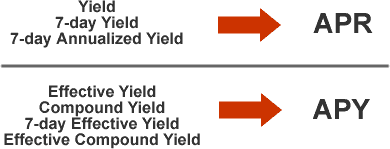
The yearly percentage yield and the seven-day yield both indicate annual returns on investment. Due to the frequent reinvestment and redemption of assets, money market funds often quote a seven-day yield. The annual percentage yield (APY) is a metric used to show the rate of return on deposit products such as savings accounts, checking accounts, and CDs, and its computation is governed by the Truth in Savings Act.
What Is the Seven-Day Yield?
The yield on a money market mutual fund over a seven-day period is a common proxy for the yield over a full year. It is a common metric used to compare different money market funds and is typically based on the fund's seven-day distribution average. The seven-day yield may be thought of as the annualized return over the last week.
The Seven-Day Yield: An Overview
Typically, money market funds' yield is determined over a seven-day period. This yield takes into account the fund's dividends and any gain over the last week, net of the average fees paid during that time period. Investors may see how several money market funds stack up by calculating their yield over a seven-day period. One possible indicator of future returns is the seven-day yield. A forecast, much like future yield, uses an average of the fund's most recent distributions as its basis.
Money market funds are a popular option for many individuals looking for a safe place to park their liquid assets. Money market funds are a common investment option for those who have retired or brokerage accounts because of the convenience of automatic sweeps. Brokerage platforms often use the seven-day yield as a comparative statistic between several money market funds.
Why Are Annualized 7-Day Yields Important?

Investors are able to compare the performance of interest-bearing accounts by using the annualized yield over the last seven days. Indicating to investors what the fund's yield would be in a year if it kept up its present earnings pace. It would be possible for accounts to alter their yield computations if this (and other standardized and necessary disclosures) were not included. The SEC provides clear guidelines for computing and applying the 7-day annualized yield. As an added bonus, it specifies how to precisely figure out things like dividend reinvestment, realized profits and losses, one-time fees, and dividend taxes.
Seven-Day Yield Comparisons
Barron's ranks the top money market funds in the industry based on their seven-day yield, both with and without compounding. This ranking displays the top money market funds in terms of yield, broken down by sector. Money market investments may be broken down into three broad categories: taxable municipal bonds, tax-exempt state and local bonds, and taxable government money market securities. If an investor purchases tax-free municipal bonds in the same state in which they live, they will not be subject to federal or state income tax.
Comparing Investment Returns
The legal approach used by the Truth in Savings Act facilitates customer comparisons of various financial products, including but not limited to savings accounts, certificates of deposit, and savings accounts offered by different financial institutions. The seven-day yield is a common metric used by investors to evaluate the performance of money market accounts. Certificates of deposit, Treasury bills, and other liquid assets are examples of low-risk short-term securities that money-market funds registered with the U.S. Securities and Exchange Commission must hold.
Example of a Seven-Day Yield
Let's take a look at a real-world use of the seven-day yield. As of January 3, 2018, the Vanguard Federal Money Market Fund (VMFXX) has the highest seven-day yield among federal money market funds. A simple yield of 1.22% and a compound yield of 1.23% are both available over a period of seven days. The most recent delivery was made on January 2, 2018, and was $0.00097, for a weekly payout average of $0.0002425.
Unless an average is utilized, the seven-day yield of a fund might fluctuate with distributions. Thus investors should proceed with caution when using this metric. Since the 30-day yield is a notional annualized return based on dividends over the previous 30 days, it may also serve as a useful comparison tool.
Are 7-Day Annualized Yield and 7-Day Effective Yield the Same Thing?

To begin, know that the 7-day annualized yield is different from the 7-day effective yield. The yield for 7 days multiplied by a year is just the basic yield annualized. Since it is assumed that revenue from the fund is compounded every seven days, the effective yield is often greater.
Conclusion
The yield over a seven-day period is the simple annual rate (more accurately, the annualized simple daily rate), which changes every day but is averaged out over that time period. That rate doesn't include compounding, so it doesn't reveal how much you'd make if the rate remained stable for a year. A bank's annual percentage yield (APY) is the effective rate after a simple rate has been compounded on a regular basis (usually monthly). You may easily calculate the annual percentage yield (APY) by adding or subtracting the compounding from the 7-day yield.



